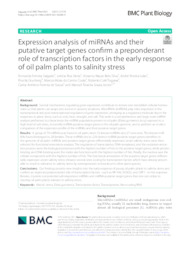Expression analysis of miRNAs and their putative target genes confirm a preponderant role of transcription factors in the early response of oil palm plants to salinity stress.
Expression analysis of miRNAs and their putative target genes confirm a preponderant role of transcription factors in the early response of oil palm plants to salinity stress.
Author(s): SALGADO, F. F.; VIEIRA, L. R.; SILVA, V. N. B.; LEAO, A. P.; GRYNBERG, P.; COSTA, M. M. do C.; TOGAWA, R. C.; SOUSA, C. A. F. de; SOUZA JUNIOR, M. T.
Publication year: 2021
Types of publication: Journal article
Unit: Embrapa Agroenergy
Observation
Some of Embrapa's publications are published as ePub files. To read them, use or download one of the following free software options to your computer or mobile device. Android: Google Play Books; IOS: iBooks; Windows and Linux: Calibre.
Access other publications
Access the Agricultural Research Database (BDPA) to consult Embrapa's full library collection and records.
Visit Embrapa Bookstore to purchase books and other publications sold by Embrapa.

